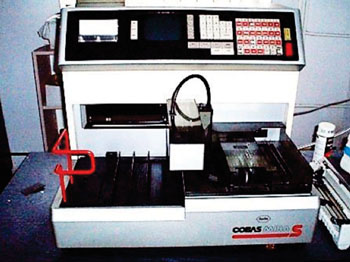Index Identifies Women at Risk for Rapid Bone Loss
By LabMedica International staff writers
Posted on 14 Jul 2016
Osteoporosis is often referred to as a "silent" disease because individuals who have it experience few noticeable symptoms and this progressive condition occurs when bones grow structurally weak and become more likely to fracture or break.Posted on 14 Jul 2016
Biochemical markers of bone resorption and formation known as bone turnover markers (BTMs) have been available for clinical purposes for many years and in postmenopausal women, BTMs are correlated with histomorphometric indices of bone turnover, especially at sites of high remodeling. Elevated BTM levels are also associated with faster rates of bone loss and increased fracture risk.

Image: The Cobas Mira S, a fully selective benchtop random access biochemistry analyzer (Photo courtesy of Roche).
Scientists at the University of California, Los Angeles (CA, USA) and their colleagues conducted a study to determine whether resorption and formation markers can be combined to gauge net bone formation across the skeleton. The 685 women, who participated in the Study of Women's Health across the Nation, were between the ages of 42 and 52. The women were either premenopausal or in early perimenopause when they enrolled in the study, and all of the participants included in this analysis had their final menstrual period during the follow-up portion of the study.
The bone formation marker, serum osteocalcin (OC), was measured using the ELSA-OSTEO immunoradiometric assay as ng/mL (Cis-Bio International, Codolet, France). The bone resorption marker, urinary N-telopeptide (U-NTX), was measured using the Osteomark competitive inhibition enzyme immunoassay as nanomoles bone collagen equivalent [BCE] (Ostex International Inc, Seattle, WA, USA). Urinary creatinine was measured using the Cobas Mira autoanalyzer (Roche Diagnostics, Basel, Switzerland). Lumbar spine (LS) and femoral neck (FN) bone mineral densities BMDs were assessed by dual-energy x-ray absorptiometry.
The scientists found that the combined measurements of bone breakdown and bone formation in a Bone Balance Index to determine each individual's net bone balance before the final menstrual period. They found that this index was a stronger predictor of bone loss from two years before the final menstrual period to three to four years later, a time when bone density typically declines than a measurement of bone breakdown alone. Urinary N-telopeptide alone was not associated with either LS or FN BMD decline.
Albert Shieh, MD, one of the study authors said, “This novel approach to assessing an individual's bone health may help identify which women are at risk of losing vertebral bone mineral density across the menopause transition. Since markers of bone breakdown alone have limited utility in predicting bone loss at an individual level, better approaches are needed to ensure individuals at highest risk of rapid bone loss are identified as quickly as possible.” The study was published on June 23, 2016, in the Journal of Clinical Endocrinology & Metabolism.
Related Links:
University of California, Los Angeles
Cis-Bio International
Ostex International
Roche Diagnostics







 Analyzer.jpg)






